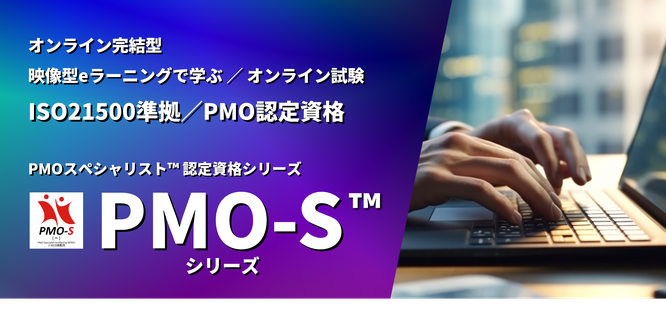- ホーム
- PMOとは
- NEWS / PR
- 協会概要
- 研修・セミナー
- 満員御礼:2025年12月10日特別セミナー
- 【法人】実践型プロジェクトマネジメント研修
- 【法人】実践型PMO研修
- 【法人】プロジェクトマネジャーのためのヒューマンスキル研修シリーズ
- 【個人・法人】<公開研修>実践型プロジェクトマネジメント研修
- 【法人】グローバル・プロジェクトマネジメント研修
- 【法人】「ビジネスモデルキャンバス」で学ぶ体験型ビジネスモデル研修
- 【法人】新規事業開発とアントレプレナーシップ研修
- 【法人】モチベーション向上研修
- 【法人】実践型ビジネスパーソン向け問題解決志向研修
- 【法人】NLP式 人を動かすコミュニケーション研修
- 【法人】リーダーシップ・フォー・チームビルディング研修
- 【個人・法人】PMO概要オンラインセミナー
- 【個人・法人】PMO講座:「ユーザー企業におけるPMO創設の薦めと具体的方法」
- 【個人・法人】PMO講座:「ユーザー企業におけるPMO導入事例とITプロジェクトを成功させる秘訣」
- 【個人・法人】自分の人生プランニングに挑戦:『じぶん計画書』セミナー
- 【個人・法人】PMI®「PDU取得シリーズ」eラーニング
- 【個人・法人】PDU取得 キャリアアップコース eラーニング
- 非営利団体向けプロジェクトマネジメント研修(Eラーニング)
- 受付終了:2025年9月24日特別セミナー
- ● 過去の公開セミナー(2023年~2025年)
- ● 過去の公開セミナー(2020年~2022年)
- 受付終了:2022年12月22日特別セミナー
- 実施レポート20221222
- 受付終了:2022年9月9日特別セミナー
- 実施レポート20220909
- 受付終了:2022年6月17日特別セミナー
- 実施レポート20220617
- 受付終了:2022年3月18日特別セミナー
- 実施レポート20220318
- 受付終了:2021年12月10日特別セミナー
- 実施レポート20211210
- 受付終了:2021年8月27日特別セミナー
- 実施レポート20210827
- 受付終了:2021年6月27日特別セミナー
- 実施レポート20210627
- 受付終了:2021年4月16日特別セミナー
- 実施レポート20210416
- 受付終了:2021年3月19日特別セミナー
- ⇒実施レポート2021/3/19
- 受付終了:2020年12月4日特別セミナー
- ⇒実施レポート2020/12/4
- 受付終了:2020年10月23日特別セミナー
- ⇒実施レポート2020/10/23
- 開催中止:特別セミナー/3月26日
- ● 過去の公開セミナー(2014年~2019年)
- 受付終了:2019年10月特別セミナー
- ⇒実施レポート2019/10/23
- 受付終了:特別講演/出版記念セミナー
- ⇒実施レポート2019/9/20
- 受付終了:2019年8月特別セミナー
- ⇒実施レポート2019/8/30
- 受付終了:2019年4月特別セミナー
- ⇒実施レポート2019/4/23
- 受付終了:2018年9月特別セミナー
- ⇒実施レポート2018/9/27
- 受付終了:2018年6月特別セミナー
- ⇒実施レポート2018/6/27
- 受付終了:NPMO大阪セミナー(第3回)
- 受付終了:PMキャリアCafe
- 受付終了:リーダーシップ・ワークショップ
- 受付終了:日本PMO協会設立3周年特別セミナー
- 受付終了: PM落語「新説 芝浜」
- ⇒実施レポート2016/12/25
- 受付終了:NPMO大阪セミナー(第2回)
- ⇒実施レポート2016/9/4
- 受付終了:日本PMO協会設立2周年特別セミナー
- ⇒実施レポート2016/4/16
- 受付終了:2016年目標設定ワークショップ
- ⇒実施レポート2015/12/15
- 受付終了:NPMO大阪セミナー
- ⇒実施レポート2015/9/19
- 受付終了:WBS要素分解 The Live セミナー
- ⇒実施レポート2015/7/2
- 受付終了:NPMO設立1周年パーティー
- ⇒実施レポート2015/4/4
- 受付終了:NPMOオープニングパーティー
- ⇒実施レポート2014/12/10
- 受付終了:マネジメント力養成セミナー20140917
- 受付終了:目標設定力養成セミナー20140723
- 資格制度
- 資格更新用教材
- 会員制度
- 出版物
- お問合せ
- FAQ
- English
- PMOアワード2025
提言記事:大規模ITプロジェクト失敗の連鎖を断つために
― PMOの形骸化を防ぎ、第三者的視点を持つ「発注者側PMO」体制の確立を ―
近年、国内の大企業において、大規模基幹システム再構築プロジェクトの失敗に関する報道が後を絶たない状況です。さらに、それに伴うIT関連訴訟も増加傾向にあるといわれています。これらは開発途中で頓挫するケースもあれば、稼働開始後に重大なシステム障害が頻発し、事業に甚大な影響を与える事例もあります。こうした場合、損害賠償請求額が数十億円から数百億円に及ぶこともあります。
経済産業省が警鐘を鳴らしてきた「2025年の崖」とは、老朽化・複雑化した既存システムがDX推進の足かせとなり、2025年以降、企業の競争力や事業継続に深刻な影響を与える可能性を指摘したものです。現実には、この警告が示す通りの「失敗続き」の状況が、プロジェクト現場で現実のものとなっています。
プロジェクトマネジメント不在・不全の現実
日本のITプロジェクトには、構造的な課題があります。特に、大規模ITシステム開発にもかかわらず、発注者側(ユーザー企業)にプロジェクトマネジメントを担うプロジェクトマネジャーやPMOが存在しない、または機能していないケースが少なくありません。
- 発注者側(ユーザー企業)にPMOやプロジェクトマネージャーが不在
- 受注者側(ベンダー企業)任せで自社側のガバナンスが効いていない
- リスクや課題が経営層に伝わらず意思決定が遅延
- 部門ごとの個別最適に終始し、全社的な視点で意思決定ができない
仮に発注者側にPMOが存在していても、リスクマネジメントや警告機能を果たせず、意思決定が遅れた結果、プロジェクトの失敗を防げない場合があります。
PMO形骸化の背景
本来、大規模ITシステム開発におけるPMOは、受注者側が担うスケジュールや品質、リソース管理だけでなく、発注者側PMOが全体ガバナンスを担い、リスクを早期に検知・対応し、必要に応じて意思決定を促す役割を果たすべきです。
しかし現実には、以下のような理由で形骸化しやすくなっています。
- 本来発注者側PMOが担うべき業務を受注者側PMOに依存し、独立性を欠く
- 会議体運営や報告書作成が目的化
- リスクや課題を経営層に率直に報告できない組織風土
- 権限不足により意思決定に関与できない
こうした形骸化は、特に大規模・長期プロジェクトで致命的な結果を招きます。
発注者側と受注者側、双方にPMOを置く意義
PMOは、発注者側(ユーザー企業)と受注者側(ベンダー企業)の双方に設置する必要があります。
-
発注者側PMO
主に、自社が利用するシステムの品質・進捗・リスクを監視し、経営層に報告・警告するガバナンス機関。契約条件や要件遵守を、ユーザー企業の視点から監督します。
-
受注者側PMO
主に、ベンダー組織内での進行管理、品質管理、納期遵守を統括します。
発注者側PMOは、受注者依存から脱却し、自社のビジネス価値を守る「防波堤」となるべき存在です。
第三者的視点を持つ「発注者側PMO」の必要性
発注者側PMOを設置しても、内部人材だけでは判断が甘くなったり、組織内での立場や調整業務に追われ、本来の機能を十分に発揮できないことがあります。特に大規模・高額案件では、次の理由から第三者的視点の導入が不可欠です。
-
独立性の確保
社内事情に左右されず、客観的な評価と提言が可能になる。 -
高度専門知識の活用
プロジェクトマネジメント、システムズエンジニアリング、ビジネスアナリシス、業界の経営知見など、多角的視点で課題を早期発見できる。 -
意思決定の迅速化
第三者の助言により、経営層がリスクを正しく認識し、迅速な判断が可能になる。

「第三者委員会PMO」という新しい枠組み
日本PMO協会は、特に大規模ITシステム開発において、発注者側PMOに「第三者委員会PMO」を設置することを提言します。
主な特徴
- 発注者組織とは独立した立場を持つ有識者をPMO構成員として招聘
- プロジェクトマネジメント専門家、IT/DX専門家、業界の経営視点を有する専門家で構成
- 社外取締役のように、経営とプロジェクトの双方に監視・助言を行う
- リスク発生時には経営層へ直接報告できる権限を付与
費用は発生しますが、数十億円単位の損害賠償や事業機会損失を防げると考えれば、十分に投資価値があると考えます。
提言
- 発注者側(ユーザー企業)と受注者側(ベンダー企業)、双方にPMOを設置すること
- 発注者側PMOには第三者的視点を持つ有識者を組み込むこと
- 大規模IT投資では「第三者委員会PMO」モデルを採用すること
- PMO機能を定期的に評価し、形骸化を防止すること
おわりに
DX推進の波は止まりません。しかし、プロジェクトの失敗は企業の競争力を大きく損ない、巨額の損害をもたらします。発注者側PMOは単なる会議運営組織ではなく、企業価値を守るためのガバナンス機関であるべきです。
「形骸化しないPMO」を実現するために、私たちは第三者的視点を持つ発注者側PMOの構築を強く推奨します。これは単なる仕組み改革ではなく、日本のITプロジェクトの成功率を高め、企業の持続的成長を支えるための必要条件であると考えます。
日本PMO協会の認定資格
PMOスペシャリスト™認定資格(NPMO認定PMO-S™)シリーズ
ISO21500準拠。PMOに特化した資格です。映像型eラーニングで学び、オンライン受験が可能。詳しくは<こちら>
「PMO-Sシリーズ」は2016年から世界で初めて(※1)運営を開始した、PMOに特化したステップアップ資格制度です。(※1 当会調べ)
プロジェクトマネジメント・アソシエイト™認定資格(NPMO認定PJM-A™)
即実践型のプロジェクトマネジメントのエントリーモデルの資格です。映像型eラーニングで学び、オンライン受験が可能。詳しくは<こちら>
Proposal Article:
Breaking the Cycle of Large-Scale IT Project Failures
— Preventing the Hollowing Out of PMOs and Establishing “Client-Side PMOs” with an Independent, Third-Party Perspective —
August 8, 2025
Nippon Project Management Office Association
In recent years, reports of large-scale core system redevelopment project failures at major Japanese corporations have shown no signs of abating. Alongside these failures, IT-related litigation is also said to be on the rise. In some cases, projects are abandoned midway through development; in others, serious system failures occur repeatedly after go-live, causing significant disruption to business operations. In such situations, damage claims can reach from billions to tens of billions of yen.
The Ministry of Economy, Trade and Industry (METI) has long warned of the so-called “2025 Digital Cliff” — the risk that aging, overly complex legacy systems will hinder digital transformation (DX) initiatives, leading to severe impacts on corporate competitiveness and business continuity from 2025 onward. Unfortunately, this warning is becoming a reality, with repeated failures now materializing in project execution.
The Reality of Absent or Dysfunctional Project Management
Japan’s IT projects face structural challenges. Notably, even in large-scale IT system development, it is not uncommon for client organizations (user enterprises) to lack a project manager or Project Management Office (PMO) — or to have them in name only, with no real function.
Common issues include:
- No PMO or project manager on the client side despite the scale of the project
- Over-reliance on vendor-side management, resulting in weak governance by the client
- Risks and issues not being escalated to executives, causing delayed decision-making
- Fragmented, department-centric optimization with no enterprise-wide decision-making
Even when a client-side PMO exists, it may fail to perform risk management or act as an early warning function, leading to delayed decisions and an inability to prevent project failure.
Why PMOs Become Hollow
In large-scale IT development, a PMO should not only manage schedules, quality, and resources on the vendor side but also serve as the governance body on the client side — detecting risks early, driving timely decisions, and ensuring alignment with contractual and business objectives.
In reality, PMOs often become hollowed out due to:
- Dependence on vendor-side PMOs for tasks the client-side PMO should own, undermining independence
- A focus on running meetings and producing reports rather than proactive management
- A corporate culture that discourages candid reporting of risks to executives
- Lack of authority to participate in decision-making
Such hollowing out can be fatal, especially in large-scale, long-term projects.
Why Both Client-Side and Vendor-Side PMOs Are Essential
PMOs should exist on both the client (user enterprise) and vendor sides.
- Client-Side PMO: Oversees system quality, progress, and risks from the client’s perspective; provides governance, reports to executives, and ensures contractual and requirements compliance.
- Vendor-Side PMO: Manages progress, quality, and delivery schedules within the vendor organization.
A client-side PMO must act as a protective barrier for the company’s business value, independent from vendor control.
The Need for an Independent, Third-Party Perspective in Client-Side PMOs
Even when a client-side PMO exists, relying solely on internal personnel can lead to lenient judgments or an excessive focus on internal politics and coordination, reducing effectiveness. This is especially dangerous for large-scale, high-value projects. Key reasons for incorporating an independent, third-party perspective include:
-
Securing Independence
Ensures evaluations and recommendations are not swayed by internal corporate politics. -
Leveraging Advanced Expertise
Brings in knowledge from project management, systems engineering, business analysis, and industry-specific business management, enabling early identification of risks. -
Accelerating Decision-Making
Third-party advice helps executives accurately understand risks and make timely decisions.
Introducing the “Third-Party Committee PMO” Model
The Nippon PMO Association recommends that, particularly in large-scale IT system development, client-side PMOs adopt a Third-Party Committee PMO structure.
Key features:
- Inclusion of external experts independent of the client organization as PMO members
- Composition of project management specialists, IT/DX experts, and industry executives
- Dual oversight of both corporate governance and project execution, similar to outside directors
- Authority to report directly to executives in the event of significant risks
While this model incurs additional costs, the investment is justified when weighed against the potential avoidance of multi-billion-yen damage claims and lost business opportunities.
Recommendations
- Establish PMOs on both the client (user) and vendor sides
- Incorporate independent experts into the client-side PMO
- Adopt the “Third-Party Committee PMO” model for large-scale IT investments
- Regularly evaluate PMO effectiveness to prevent hollowing out
Conclusion
The push for digital transformation will not slow down. However, project failures can severely damage corporate competitiveness and cause immense financial losses. A client-side PMO must be more than a meeting facilitator — it must serve as a governance body dedicated to protecting corporate value.
To achieve a PMO that does not become hollow, we strongly recommend building client-side PMOs with an independent, third-party perspective. This is not merely an organizational reform; it is a prerequisite for increasing the success rate of Japan’s IT projects and supporting sustainable corporate growth.


